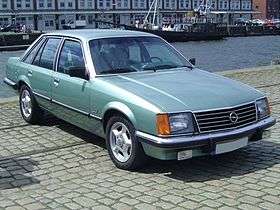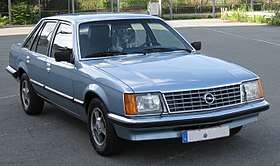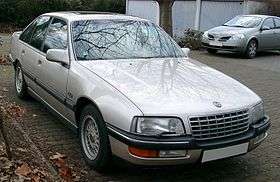Opel Senator
| Opel Senator | |
|---|---|
 A first-generation Opel Senator | |
| Overview | |
| Manufacturer | Opel |
| Production | 1978–1993 |
| Body and chassis | |
| Class | Full-size luxury car |
| Chronology | |
| Predecessor | Opel Diplomat |
| Successor | Opel Insignia concept (indirectly) |
The Opel Senator is a full-size luxury car produced by the German automaker Opel, two generations of which were sold in Europe from 1978 until 1993. A saloon, its first incarnation was also available with a fastback coupé body as the Opel Monza and Vauxhall Royale Coupé.[1]
Through the international divisions of General Motors, it was also known in various markets as the Chevrolet Senator, Daewoo Imperial (in South Korea), Vauxhall Royale (until 1983) and Vauxhall Senator (which took the place of the Royale on Vauxhall models when the Opel brand was phased out from 1983).[2] It was also sold as the Opel Kikinda in Yugoslavia, where it was produced under licence by IDA-Opel in Kikinda, Serbia, after which it was named.[3]
The original Senator shared its platform with the smaller Opel Rekord, the latter being lengthened to make the Senator.
The second generation of that car, from 1987, shared its base with the Opel Omega, which was again lengthened to produce the Senator.
Senator A (1978–1986)
| Senator A | |
|---|---|
 | |
| Overview | |
| Also called |
Chevrolet Senator Opel Kikinda[3] Vauxhall Royale Vauxhall Senator |
| Production | 1978–1986 |
| Assembly |
Rüsselsheim, Germany Kikinda, Yugoslavia |
| Body and chassis | |
| Body style | 4-door saloon/Serbia |
| Layout | FR layout |
| Platform | V platform (RWD) |
| Related |
Bitter SC Coupé Opel Monza |
| Dimensions | |
| Wheelbase | 2,685 mm (105.7 in) |
| Length | 4,810 mm (189.4 in) |
| Width | 1,722 mm (67.8 in) |
| Height | 1,415 mm (55.7 in) |
| Curb weight | 1,640 kg (3,616 lb) |
The Senator A was a lengthened version of the Opel Rekord E, complemented by a three-door fastback coupé version on the same platform called the Opel Monza, which was planned as a successor for the Opel Commodore coupé.
Names and markets
The Senator A and Monza were initially sold in the United Kingdom as the Vauxhall Royale (and Vauxhall Royale Coupé), because the Opel marque was not so well established, but they were also under their Opel names. The vehicle was also available in South Africa as the Chevrolet Senator until 1982, when it was re-badged as an Opel.[4] The Chevrolet Senator was fitted with a locally built version of Chevrolet's 250 inline-six (4,093 cc), with 132 PS (97 kW).[5] The later South African Opel Senator received Australian-built six-cylinder engines.
- Opel Senator A1 rear
(1978–1986) - In the UK, the Senator A was badged as Vauxhall instead of an Opel.
Engines
The engine range for the first phase of the model's life included the 2.8S and the newly developed 3.0E, which had 180 PS (132 kW; 178 hp) and 248 N·m (183 lb·ft) with fuel injection. The 3-speed[automatic transmission]]was Opel's own design introduced in 1969 and was manufactured in Opel's transmission plant in Strasbourg, it was modified to cope with the new and improved power outputs. Opel's own 4-speed manual transmission was not up to the job and Opel turned to transmission producer Getrag, and installed their 264 4-speed manual gearbox in the early Monzas with 4- cylinder engine. This was immediately replaced by the 5-speed manual Getrag 240 for the 2.5 and 2.8 engines, and the Getrag 265 for the 3.0E.
The straight-six engines were all of the CIH (camshaft in head) same design earlier used in the Commodore models. The CIH configuration is originated from the 1,7 and 1,9 litre straight 4 engines that was first used in the Opel Kadett and Rekord models in 1966, and subsequently was an engine layout that stayed in the Opel cars up until 1993 (the last CIH engine factory mounted was a 2,4 litre straight 4 CIH used in the Opel Frontera).
With the 3.0 litre engine, the Monza was the fastest car Opel had built up until then, capable of speeds of 215 km/h (134 mph), and 0–100 km/h (0–62 mph) in 8.5 seconds. As of June 1981 the fuel injected 2.5E engine also used in the smaller Commodore was added to the Senator/Monza lineup.[6] With 136 PS (100 kW) it was very close to the now irrelevant 2.8 and its 140 PS (100 kW), and the 2.8S was discontinued in 1982.
1982 facelift
The original Senator and Monza were facelifted in November 1982, although the Senator "A2" (as it is usually called) only went on sale in March 1983. In the UK, it was initially sold only as an Opel, before being re-badged as a Vauxhall in 1984. The A2 Monza was only sold as an Opel.
The facelifted car looked similar to its predecessor, with relatively minor changes: headlights increased in size, and chrome parts were changed to a matt black or colour-coded finish. The car was much more slippery, with drag resistance down by around ten percent.
Interiors were improved, and engines changed. Now, straight-four CIH 2.0E and 2.2E engines from the Rekord E2 were available; these new smaller engined models essentially replaced the Commodore which was quietly retired in 1982. Later in 1983 the 2.5E was given a new LE-Jetronic Bosch fuel injection system. The 2.8S been replaced before the Senator A1 was replaced, and the 3.0E and a new 3.0H engine were at the top of the range. The 3.0E received upgraded Bosch fuel injection. A 2.3-litre turbodiesel (shared with the Rekord) became available in 1984, and in November a supercharged version (Comprex) was shown. The only produced car in the world which have used this technique. Going on sale in 1985, this very rare experimental version (1,000 units planned) were officially built by Irmscher rather than Opel.[7] The Comprex offered 95 PS (70 kW) and a 172 km/h (107 mph) top speed; like the other diesels it had a pronounced bulge in the bonnet. From September 1985 until the end of production in late summer 1986 a catalyzed version of the 3.0E was available, with power down to 156 PS (115 kW).
 Opel Senator A2 (1982–1986)
Opel Senator A2 (1982–1986) Opel Senator A2 rear
Opel Senator A2 rear
Variants
A four-wheel drive conversion was also available, engineered by Ferguson, who had previously provided similar modifications for the Jensen FF. Rather expensive, this could also be retrofitted to an existing car.[8] These were used by British Forces Germany under the BRIXMIS (British Commanders'-in-Chief Mission to the Soviet Forces in Germany) operations for the collection of technical intelligence. The same kit was also used by Bitter Cars for their SC coupé, beginning in late 1981.[8]
A limited edition convertible edition was also available in Germany, where the company "Keinath" reinforced the car heavily, and this added to the all round weight to the car.
German tuner and manufacturer Irmscher also made a special "Irmscher" version of the Monza, and added small sideskirts and frontspoiler. The engine gained a considerable upgrade: The 3.0 litre engine got a reshaped crankshaft and different pistons and rods increasing the capacity to 3.6 litres. A remapped ECU was added to the Bosch injection system giving the car 206 PS (152 kW), and extra torque.
Senator B (1987–1993)
| Senator B | |
|---|---|
 | |
| Overview | |
| Also called | Vauxhall Senator |
| Production | 1987–1993 |
| Assembly | Rüsselsheim, Germany |
| Body and chassis | |
| Body style | 4-door saloon/sedan |
| Layout | FR layout |
| Platform | V platform (RWD) |
| Powertrain | |
| Engine | |
| Transmission |
4-speed automatic 5-speed manual |
| Dimensions | |
| Wheelbase | 2,730 mm (107.5 in) |
| Length | 4,845 mm (190.7 in) |
| Width | 1,785 mm (70.3 in) |
| Height | 1,455 mm (57.3 in) |
| Curb weight | 1,640 kg (3,616 lb) |
A new model, the Senator B (marketed without the "B" suffix), arrived in spring 1987, a long-wheelbase version of the Opel Omega. There was no Monza equivalent.
There were various versions of the Senator B: 12-valve 2.5 L and 3.0 L sized engines were released in 1987 along with a luxury "CD" model with the 3.0 L engine. The CD version boasted adjustable suspension, air conditioning, heated seats also in the backseat, genuine walnut panels, leather-covered center console, trip computer and cruise control. The cars were available with either 5-speed manual or 4-speed automatic gearboxes. As a luxury car, there were many options but much was also standard, option was leather seats and heated seats both front and rear, electronic air conditioning including refrigerator in the glove box, (It was Opel Senator who initiated the trend with refrigerated compartments which today the majority offer. And the first to take after this luxury equipment was Mercede in the new E-klass 1995.) LCD instrumentation was an option, digital electronic power steering ZF-Servotronic, the same as in the BMW 7 series was standard, standrad was also an revolutionary new front axle which allowed the front axle to slide under the car in a crash and thus increasing the length of the deformation zone and prevent deformation of the footwell. This technology was an Opel patent, and the first second car manufacturer who used the solution was Mercedes in E-klass 1995. The 3.0 24V was standrard equipped with BBS styled multispoke alloy wheels made by Ronal.
A 24-valve 3.0 L was introduced in 1989, generating 204 PS (150 kW; 201 hp) (compared with 177 PS (130 kW; 175 hp) for the older 12-valve version). This model was very popular with the police force in the UK, with several cars being supplied to upgraded police specification. The main feature of the new engine was a "Dual Ram" system, increasing torque at low engine speeds by means of a redirected air flow system engaged at 4,000 rpm.
Later in the model's lifespan, the 2.5 L was replaced by a 2.6 L Dual Ram, and the 3.0 L 12-valve was deleted in 1992. CD versions of the 2.6 L and 24-valve 3.0 L were available up to the model's withdrawal in 1993.
When the second-generation Omega was released in 1994, Opel considered that it was sufficiently represented in the upper end of the market by the top-specification Omega Elite. Consequently, the Senator was cancelled in May 1993 and not directly replaced.
 Opel Senator B rear
Opel Senator B rear- In Britain, the Senator B was marketed as the Vauxhall Senator
- Police livery Senator B
| Technical data of Opel Senator B (1987–1993) | |||||||
| Opel Senator | 2.5 i 25NE | 2.6 i C26NE | 3.0 i C30NE | 3.0 i C30SE | Irmscher 4.0 i C40SE | ||
|---|---|---|---|---|---|---|---|
| Engine: | I-6 – 12V | I-6 – 24V | |||||
| Displacement: | 2490 cc | 2594 cc | 2969 cc | 3983 cc | |||
| bore x Stroke: | 87 x 69,8 mm | 88,8 x 69,8 mm | 95 x 69,8 mm | 98 x 88 mm | |||
| Max power @ rpm: | 140 PS (103 kW) @ 5200 | 150 PS (110 kW)@ 5600 | 156 PS (115 kW) @ 5400 177 PS (130 kW) @ 5800 | 204 PS (150 kW) @ 6000 | 272 PS (200 kW) @ 5800 | ||
| Max torque @ rpm: | 201 N·m (148 lb·ft) @ 4000 | 216 N·m (159 lb·ft) @ 3600 | 200 N·m (148 lb·ft) @ 3900 235 N·m (173 lb·ft) @ 4400 | 265 N·m (195 lb·ft) @ 3600 | 387 N·m (285 lb·ft) @ 3300 | ||
| Injection: | Multipoint (Bosch LE-Jetronic) | Multipoint (Bosch Motronic) | |||||
| Cooling: | water | ||||||
| Transmission: | 4-sp automatic, 5-sp manual | 5-sp manual | |||||
| Brakes: | Front: ventilated disc brakes Ø 280 mm, rear: ventilated disc brakes Ø 270 mm | Front: ventilated disc brakes Ø 296 mm, rear: disc brakes Ø 270 mm | |||||
| Body structure: | Sheet steel, unibody construction | ||||||
| Track front/rear: | 1462/1484 mm | ||||||
| Wheelbase: | 2730 mm | ||||||
| Length: | 4845 mm | ||||||
| Dry weight: | 1440–1640 kg | ||||||
| Top speed: | 210 km/h (130 mph) | 215 km/h (134 mph) | 225 km/h (140 mph) | 240 km/h (149 mph) | 255 km/h (158 mph) | ||
| 0–100 km/h: | 10.5 s | 9.8 s | 9 s | 7.8 s | 6.5 s | ||
| Fuel consupmtion: | 13.0 l | 12.5 l | 13,0–13.5 l | 12.5 l | 14.5 l | ||
Notes
- ↑ Vauxhall Royale and Royale Coupe (1978 - 1984), Honest John, 22 August 2013
- ↑ "Austin Rover Online". Aronline.co.uk. Retrieved 2011-03-21.
- 1 2 Sajam Automobila U Beogradu 1986. Godine
- ↑ Chevrolet Senator
- ↑ Büschi, Hans-Ulrich, ed. (March 3, 1982). "Automobil Revue '82" (in German and French). 77. Berne, Switzerland: Hallwag, AG: 250–251. ISBN 3-444-06062-9.
- ↑ Automobil Revue '82, pp. 432-433
- ↑ Mastrostefano, Raffaele, ed. (January 1985). "Anteprima: Futuro Prossimo" [Preview: The Future is Near]. Quattroruote (in Italian). Milan, Italy: Editoriale Domus. 30 (351): 61.
- 1 2 Frère, Paul. "Hat der Vierradantrieb eine Zukunft?/L'avenir des quatre roues motrices?" [Does four-wheel drive have a future?]. Automobil Revue '82 (in German and French): 101.
References
External links
| Wikimedia Commons has media related to Opel Senator. |
« previous — Opel car timeline, 1980s–present | ||||||||||||||||||||||||||||||||||||||
|---|---|---|---|---|---|---|---|---|---|---|---|---|---|---|---|---|---|---|---|---|---|---|---|---|---|---|---|---|---|---|---|---|---|---|---|---|---|---|
| Type | 1980s | 1990s | 2000s | 2010s | ||||||||||||||||||||||||||||||||||
| 0 | 1 | 2 | 3 | 4 | 5 | 6 | 7 | 8 | 9 | 0 | 1 | 2 | 3 | 4 | 5 | 6 | 7 | 8 | 9 | 0 | 1 | 2 | 3 | 4 | 5 | 6 | 7 | 8 | 9 | 0 | 1 | 2 | 3 | 4 | 5 | 6 | 7 | |
| City car | Agila A | Agila B | Karl | |||||||||||||||||||||||||||||||||||
| Adam | ||||||||||||||||||||||||||||||||||||||
| Supermini | Corsa A | Corsa B | Corsa C | Corsa D | Corsa E | |||||||||||||||||||||||||||||||||
| Chevette | ||||||||||||||||||||||||||||||||||||||
| Small family car | Kadett D | Kadett E | Astra F | Astra G | Astra H | Astra J | Astra K | |||||||||||||||||||||||||||||||
| Ampera | Ampera-e | |||||||||||||||||||||||||||||||||||||
| Large family car | Ascona B | Ascona C | Vectra A | Vectra B | Vectra C / Signum | Insignia A | Insignia B | |||||||||||||||||||||||||||||||
| Executive car | Rekord E / Commodore C | Omega A | Omega B | |||||||||||||||||||||||||||||||||||
| Full-size car | Senator A | Senator B | ||||||||||||||||||||||||||||||||||||
| Coupé | Tigra A | |||||||||||||||||||||||||||||||||||||
| Manta B | Calibra | |||||||||||||||||||||||||||||||||||||
| Monza | ||||||||||||||||||||||||||||||||||||||
| Convertible | Tigra TwinTop B | Cascada | ||||||||||||||||||||||||||||||||||||
| Sports car | Speedster | GT (Roadster) | ||||||||||||||||||||||||||||||||||||
| Mini MPV | Meriva A | Crossland | ||||||||||||||||||||||||||||||||||||
| Compact MPV | Meriva B | |||||||||||||||||||||||||||||||||||||
| Zafira A | Zafira B | |||||||||||||||||||||||||||||||||||||
| Large MPV | Sintra | Zafira Tourer C | ||||||||||||||||||||||||||||||||||||
| Mini SUV | Mokka | |||||||||||||||||||||||||||||||||||||
| Compact SUV | Frontera A | Frontera B | Antara | Grandland | ||||||||||||||||||||||||||||||||||
| Mid-size SUV | Monterey | |||||||||||||||||||||||||||||||||||||
| Pick-up | Campo | |||||||||||||||||||||||||||||||||||||
| LAV | Kadett Combo | Combo B | Combo C | Combo D | ||||||||||||||||||||||||||||||||||
| Van | Bedford Blitz | Arena | Vivaro A | Vivaro B | ||||||||||||||||||||||||||||||||||
| Movano A | Movano B | |||||||||||||||||||||||||||||||||||||

